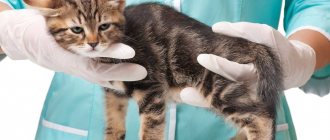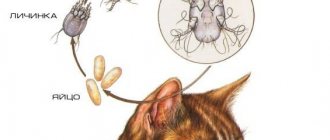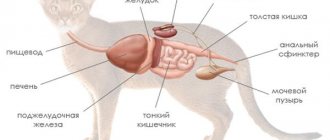Pyelonephritis in cats is a serious disease in which the renal pelvis is affected by a bacterial infection. Proper treatment for this problem is necessary, because without it, the animal may develop kidney failure. To prevent this from happening, the owner must know the symptoms of pyelonephritis, which will allow him to seek veterinary help in time and eliminate the risk of complications.
Reasons for the development of the disease
This disease can develop in cats regardless of gender and age, but most often it is diagnosed in purebred, neutered and old cats. The course of this disease can be expressed in acute and chronic forms.
Reasons for the development of the disease:
- Slowing down the process of urination, stagnation of urine.
- Kidney damage from bacterial infections.
- The appearance of stones in the urinary tract.
- Damage to the body and its individual organs by parasites.
- Reaction to certain drugs and harmful substances.
Regardless of the reasons that caused this disease , it needs urgent treatment, because the more neglected it is, the more difficult it is to fight it.
What is pyelonephritis?
Pyelonephritis is an inflammation of the kidney tissue, affecting mainly the pelvis, calyces and parenchyma. In the absence of timely treatment, the inflammatory process spreads to the blood vessels and renal glomeruli. As a rule, the disease is provoked by a bacterial infection that penetrates the kidneys through an ascending or descending (hematogenous) route. Often the cause of the disease is stagnation of urine in the pelvis, penetration of pathogenic microorganisms from the urethra or genitals, and parasites. The following types of pyelonephritis are distinguished (by form):
- hemorrhagic - develops as a result of fragility of the blood vessels in the kidneys;
- catarrhal - an acute form of the disease, easily treatable;
- purulent - a severe form of the disease, characterized by the accumulation of pus in the kidney tissue.
According to the nature of the disease, there are 2 types of disease - acute and chronic. The latter appears as a result of untimely treatment of the acute form and is characterized by periods of remission and periodic exacerbations throughout life. According to the etiology, pyelonephritis can be primary (when the infection occurs in the kidneys) and secondary, in which bacteria migrate into the kidney tissue from other organs through the bloodstream.
How to recognize the disease
If there is no treatment, pyelonephritis can lead to irreparable consequences: the development of renal failure, sepsis and death. For this reason, it is very important to pay attention in time to warning symptoms that may indicate the development of the disease. Having noticed one or more signs of pyelonephritis in a cat, the owner is obliged to take the animal to the veterinarian as soon as possible.
The main symptoms of pyelonephritis in cats:
- The cat is in a feverish state;
- The animal is constantly lethargic and apathetic;
- Increased thirst (polydipsia);
- Vomiting, lack of appetite, diarrhea;
- Increased amount of urine;
- Pain when urinating, indicated by the cat’s plaintive meow;
- When touched on the back or stomach, the cat experiences pain and escapes;
- The color and smell of urine changes;
- The animal's pulse and breathing quicken.
As a rule, with pyelonephritis, the above-described signs are observed in combination, so they can be easily noticed even by an owner who is far from veterinary medicine. But treatment should only be carried out by a specialist. Therefore, at the first symptoms of pyelonephritis, you should contact your veterinarian.
Pyelonephritis can affect not only the kidneys, but also the ureters and urethra. The impetus for the development of the disease is often problems with the immune system and blood supply to the kidneys. Also, pyelonephritis can be accompanied by the appearance of stones in the urinary organs, which injure the membranes of the bladder and kidneys, which contributes to the development of infection. If the cat is not treated, then over time the ureters may become clogged and blood poisoning may develop.
What is pyelonephritis in dogs and cats?
Pyelonephritis is a bacterial inflammation of the kidneys, the inflammation is concentrated in the renal pelvis, convoluted tubules and adjacent tissues.
Inflammation occurs when bacteria penetrate upward from the bladder and urethra, especially with anomalies in the anatomical structure of the ureters. When the infection spreads hematogenously through the blood from other foci of inflammation, this path in the development of pyelonephritis can lead to a kidney abscess - complete purulent melting of the kidney.
Causes of pyelonephritis in dogs and cats
Colds, weakened immunity and purulent processes in any organs and tissues of the body. Most often as a consequence of cystitis, prostatitis, purulent inflammation of the uterus.
Symptoms - signs of pyelonephritis in animals
With a chronic, sluggish course of the disease, there may be no external signs and only changes in urine and blood tests.
In acute cases of pyelonephritis, a sharp pain in the kidney area is noted - the lower back, an increase in temperature up to 40 degrees, the animal is hunched over, lethargy, and sometimes refusal to eat.
In all forms, hypertension can be observed - a significant increase in blood pressure.
Diagnosis of pyelonephritis in dogs and cats
The diagnosis of pyelonephritis is made by urine analysis - a lot of leukocytes are detected, while there may be a few red blood cells or a lot if there is both pyelonephritis and glomerulonephritis.
An ultrasound of the kidneys can be performed - the kidneys may be enlarged, swollen, in the later stages lumpy, swollen and melted in the case of a kidney abscess.
Usually the disease affects both kidneys, but unilateral pyelonephritis also occurs.
Clinical signs of the disease are taken into account, including elevated blood pressure in the absence of signs of congestive heart failure.
Treatment of pyelonephritis in dogs and cats
The basis of treatment is the use of antibiotics.
The most suitable group of fluoroquinolones is ciprofloxacin, tsifran, baytril.
The use of other antibiotics in dogs with pyelonephritis can be considered unjustified, especially in cases of a chronic process. Because treatment of animals usually does not begin at an early stage of the disease, and time spent on selecting an antibiotic can have a detrimental effect on the condition of the kidneys. Therefore, you must immediately begin treatment with the most suitable antibiotic - ciprofloxacin and analogues.
An antibiotic usually has to be used for a long period of 10 – 20 – 30 days, sometimes 2 – 6 months, in rare cases constantly, when pyelonephritis has led to renal failure and the antibiotic penetrates very poorly into the urine and cannot suppress the purulent process.
Among the auxiliary agents are immunostimulants that increase the body's response to infection, especially during a long-term illness, when the immune system is depleted.
Plasmapheresis to improve filtration and improve the penetration of the antibiotic into the urine, to improve immunity.
Antispasmodics – no-spa, and for particularly severe pain, analgin.
Enap to reduce blood pressure. Doses are selected under the control of regular blood pressure measurements.
Monitoring the treatment of pyelonephritis in cats and dogs
For control, urine tests are carried out first once every 7-15 days until complete recovery, then 1-2 times a year.
Blood tests to check for kidney failure and liver problems.
Monitoring blood pressure until normalization and then as a clinical examination.
Outcome – prognosis of pyelonephritis in animals
With a favorable course and early initiation of treatment, complete recovery can occur.
In advanced cases, chronic pyelonephritis develops with periods of exacerbation and remission. In the later stages of kidney damage, kidney failure occurs in cats and dogs.
Prevention of pyelonephritis in cats and dogs
Because mild forms of pyelonephritis often occur secretly, many animal owners are unaware of the disease until serious changes occur in the kidneys leading to renal failure.
For the timely detection and treatment of kidney diseases, there is a medical examination, that is, a low-cost preventive examination consisting of tests: a general clinical urine test, a general clinical blood test, blood biochemistry.
Such an examination is recommended to be carried out once a year or after any illness.
If desired, possible and if necessary, an ultrasound examination and a survey x-ray can be performed annually.
All about piroplasmosis in dogs
Special attention!
The most common complication of piroplasmosis is renal failure.
The use of plasmapheresis in the treatment of piroplasmosis increases the chances of survival of dogs.
Diagnostics
If there is a suspicion of pyelonephritis in a cat, the veterinarian will prescribe an examination for an accurate diagnosis and treatment. It is worth noting that some symptoms of pyelonephritis are similar to those of nephrosis, polycystic kidney disease or nephritis. Therefore, the specialist’s task is to exclude these diseases.
Diagnostic methods:
- general blood analysis;
- blood chemistry;
- Ultrasound of the abdominal cavity and urinary organs;
- analysis of urine from the bladder and renal pelvis for the presence of bacteria;
- kidney biopsy;
- radiography;
- excretory urography.
Diagnostic methods to confirm the presence of the disease are determined by the veterinarian depending on the complexity of the symptoms and the pet’s individual medical history. Also, the choice of examination method depends on the conditions of the veterinary clinic and the availability of special diagnostic equipment. If the examination reveals stones in the kidneys or bladder, it is necessary to get rid of them, and only then begin treatment. Otherwise, the therapy will not give a positive result.
The prognosis for treatment of pyelonephritis depends on the severity of the disease, the age of the cat and the timeliness of veterinary care.
Symptoms of pyelonephritis
The animal begins to develop a fever and has difficulty urinating. The pet urinates often and painfully, while emitting a plaintive meow. The cat is lethargic, with low activity, and often shows aggression towards its owner. The presence of acute pain in the lumbar region.
When a cat is sick, it urinates frequently and painfully.
Purulent pyelonephritis is manifested by increased thirst and weakness. Severe vomiting begins and appetite disappears. This phenomenon is fraught with serious consequences, including complete kidney failure.
Establishing diagnosis
To make a diagnosis, urine is collected.
- The diagnosis is made based on anamnesis, urine and blood are collected for laboratory testing.
- Ultrasound examination of the lumbar region and abdominal cavity.
Treatment of the disease
Pyelonephritis is a serious disease that is very difficult to cure. In order to get rid of it, you must follow the veterinarian's instructions flawlessly.
Treatment of pyelonephritis involves the following:
- The use of antibiotics to rid the renal pelvis of a bacterial infection that causes pyelonephritis.
- Providing the cat with cozy and comfortable living conditions, protecting it from stress and overwork.
- Adjusting your cat's diet. It should contain fermented milk products and vegetables. All other food is prohibited during the treatment period.
- Use of painkillers.
- Use of antimicrobial drugs.
It is important to note that antibiotics should only be given to a cat as prescribed by a doctor. Only a veterinarian will be able to select the drug and the correct dosage, which will help in treatment and not harm . Typically, for pyelonephritis, the use of antibiotics alternates with antiviral drugs. Droppers or herbal tinctures that have a diuretic effect may also be additionally prescribed.
The antibiotic is selected based on the results of urine tests. Treatment of pyelonephritis is quite long. As a rule, it is about one and a half months. In some cases, it may be necessary to treat the animal in a hospital. In any case, the treatment process should occur under the supervision of a veterinarian.
Preventive measures
The main rule that will help avoid the occurrence of pyelonephritis in a cat is timely treatment of any diseases. Infection of the renal pelvis can be caused by gynecological, colds, as well as problems with the animal’s genitourinary system. Therefore, it is very important to contact a veterinarian at the first signs of illness. In addition, an important condition for preventing pyelonephritis is keeping the cat warm and dry. You should regularly take the animal for a walk and provide it with a balanced diet, which will contain a sufficient amount of vitamins and minerals for the normal functioning of the body.
By bringing a cat into the house, the owner obliges himself to take care of it. The main manifestation of care is attention to your pet, thanks to which you can notice the disease in the early stages and quickly get rid of it without consequences for the small furry creature.











